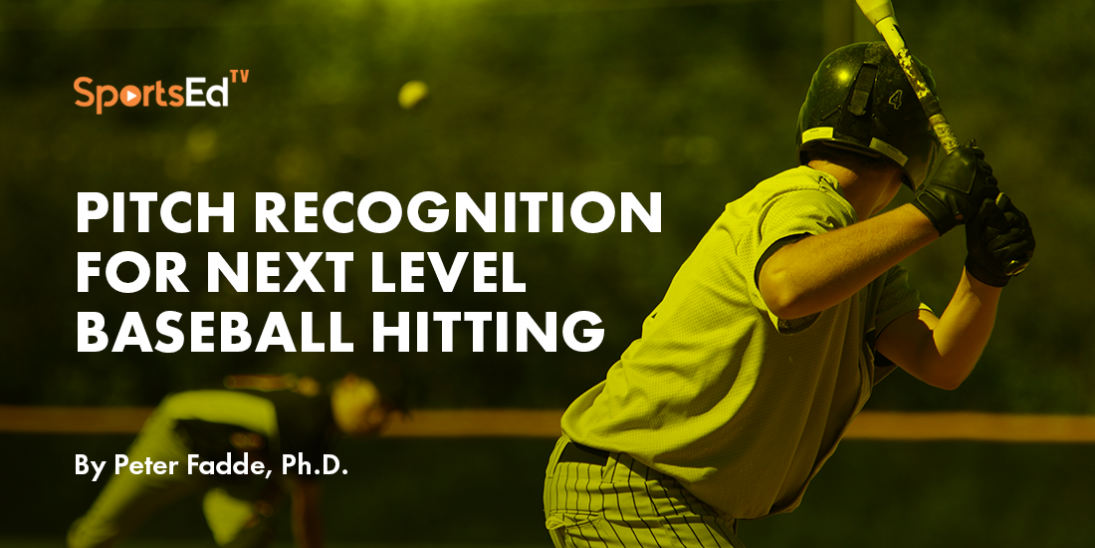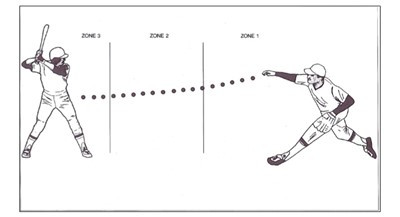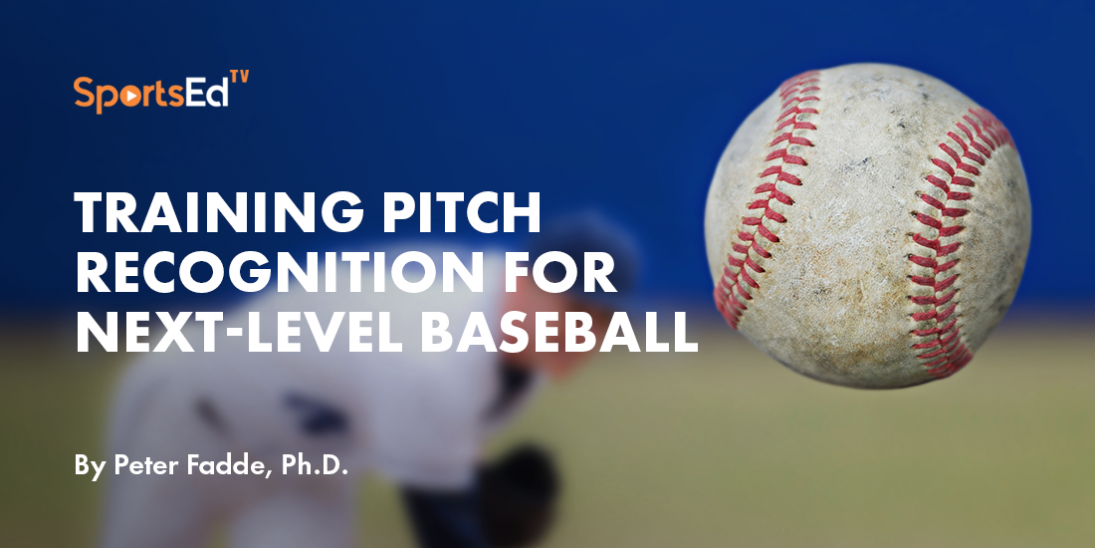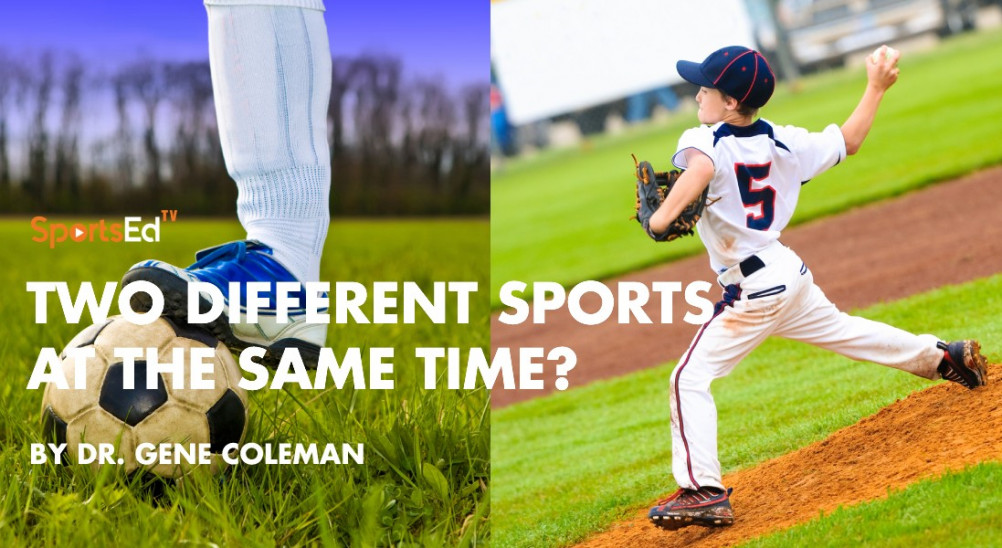Baseball
Welcome and thanks for visiting...

Pitch Recognition for Next Level Baseball Hitting

Baseball hitting coaches love to say, “Hitting is hard.” I’m here to tell you that hitting isn’t hard. It’s impossible. Human vision can’t track any pitch over about 83 miles-per-hour (134 kph) to the bat. Getting square contact on a round ball with a round bat gives no more than a one-inch (2.5 cm) margin of error. High-level pitches not only travel at speeds up to 100 miles-per-hour (160 kph) but also move in unpredictable ways due to gravity, spin, Magnus effect, and other forces. It’s hard to argue with Ted Williams’ (the last major leaguer to hit .400) claim that hitting is “the most difficult thing in sport.”
So how do skilled batters not only hit well-pitched baseballs but also hit them very hard and very far? It’s all workarounds. Hitters and hitting coaches relentlessly work on swing mechanics to generate bat speed and attack angles necessary to drive the ball. But they all will tell you that mechanics mean little without good timing to deliver the barrel of the bat to the ball at the optimal time and place in the hitting zone.
So, where does timing come from? Stance and swing mechanics help hitters get two eyes on the pitcher, minimize head movement, get their front foot down “on time,” and launch their swings in synch with the pitcher’s motion. But timing also involves pitch recognition. Good swing mechanics maximize the amount of time (and milliseconds matter) that hitters have to shut down their swing, if needed, or to make in-swing adjustments that get the barrel of the bat to the ball.
Pitch recognition is not as well understood or as frequently coached as swing mechanics. Therefore, pitch recognition is not only an important aspect of hitting but also a way to gain a competitive advantage by improving a part of hitting that your competition (including the guy next to you on the bench) is not. In this article, I clarify what pitch recognition is, along with why it is important. In a companion article, I will explain when, where, and how to train pitch recognition.
What is Pitch Recognition?
It helps clarify what pitch recognition is by considering what it is not. Pitch recognition is not vision. Obviously, good vision is valuable for hitting, and many major league hitters have15/20 vision or better. However, not all good hitters have superior vision, and not all hitters with superior vision are good hitters. In addition, while vision is correctable, it is not particularly trainable. On the other hand, visual skills such as convergence and divergence are trainable with a variety of devices and computer/smartphone apps (for example, Slow the Game Down and Visual Edge). As important as visual skills are to hitting, however, it is a mistake to assume that training visual skills will automatically improve the perceptual skill of pitch recognition.
Perception is the meaning that you draw from what you see. It’s not “seeing” the pitch so much as it is “reading” the pitch. “Know the story of the pitch, know the story of the [bat] path,” says major league hitting coach John Mallee. The story of the pitch has three chapters, or Zones, in this illustration from Harvey Dorfman’s Mental Skills of Baseball:

Zone 1 is the pitcher’s motion, release of the pitch, and first 10-12 feet of ball flight. In this zone/chapter, hitters are able to read clues as to the type of pitch being thrown. For example, a traditional 12-to-6 curveball requires the pitcher’s fingers to come over the ball to “pull the shade,” – which hitters can pick up as a “skinny wrist” or karate chop movement. Mike Schmidt said that he could pick up sliders from left-handed pitchers by the “out and around” trajectory of the ball coming out of the pitcher’s hand. But he couldn’t pick up the same clue from a same-handed (right-handed for Schmidt) pitcher.
Zone 2 is where hitters read spin. Some hitters say they see the spin of the seams, some say they don’t. More likely, hitters see spin clues. For instance, many hitters report seeing a red or white, quarter or dime-sized “hole” in sliders. The visual clue is caused by the seam pattern of sliders rotating on a tilted axis while the ball is moving straight. Picture a spinning bicycle wheel at an angle so that you can see the hub of the wheel with the spokes rotating around it. The hub is the hole. Hitters also report seeing color cues, such as a 4-seam fastball appearing redder than a 2-seam fastball. Some hitters say that split-finger fastballs appear to tumble. But these kinds of pitch clues are highly individual, and many hitters can’t verbalize clues that their subconscious mind actually uses.
At high levels, hitters need to commit to their swing in Zone 2 with the pitch just over halfway to the plate. Zone 3 is the hitting zone. The swing can no longer be halted. Hitters usually move their heads and eyes down to the hitting zone as the ball enters Zone 3, but they do not actually see the bat meet the ball. Rather than tracking the ball to contact the head/eye movement, he is aiming ahead of the pitch like a bow hunter leading his shot. As Dusty Baker said in You Can Teach Hitting, “You hit the slider with your imagination.”
Again, an illustration from Dorfman’s Mental Skills of Baseball shows the three “plots” that the story of most pitches follows:

Hitters’ brains unconsciously and almost instantaneously fill in the dots and mentally picture the shape of a pitch. Hitters automatically know the story of a standard, straight fastball (A) before it leaves Zone One. And their well-trained swing knows the story of the bat path to intercept it. Unfortunately, for hitters, pitchers manipulate the ball to, as Greg Maddux said, “make strikes look like balls and balls look like strikes.”
This is where hitters’ brains draw upon their deep mental database of pitches to recognize patterns and connect the dots to either lay off the chase pitch (B) or to stay on the freeze pitch (C). Pitch recognition is reading the story of the pitch as early and as accurately as possible in order to make better swing decisions and adjustments. Some hitters use pitch recognition to have good plate discipline – meaning that they swing at strikes and don’t swing at balls. But pitch recognition also is what makes selectively aggressive hitters such as Ted Williams, Albert Pujols, and Juan Soto impossible to pitch to.
When, Where, and How to Train Pitch Recognition
In this article, I covered what pitch recognition is (and isn’t) and why it is associated with the most dangerous and productive hitters. Hitters that aspire to next-level success, whether that’s making varsity as a freshman, playing elite travel ball, being recruited to play in college, or advancing in professional baseball, greatly increase their chances by consciously and conscientiously working on pitch recognition. And the earlier they start, the better. In a companion article, I cover when hitters should start working on pitch recognition (ideally, before they need it), where to work on pitch recognition (team? instructor? facility?), and how hitters can work on and improve their pitch recognition.
References
Mallee, J. The Story of the Pitch; the Story of the Path, lead clinic at John Mallee Major League Hitting Clinics, 2020. https://www.majorleaguehittingclinics.com/
Dorfman, H. A. and Kuehl, K. The Mental Game of Baseball: A Guide to Peak Performance. Rowman &; Littlefield Publishing. 1989.
Fadde, P. “The Sixth Tool: Training Baseball Pitch Recognition” (Amazon e-book). With citations from hitting books by Dusty Baker, Mike Schmidt, and Ted Williams.








